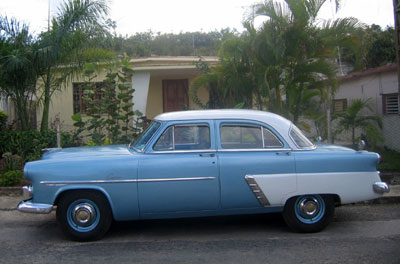I once had a house guest from South America. During his visit, I happened to throw an old, broken blender in the trash. The next day it was sitting on my counter – in working order. In his world, people simply cannot afford to replace a malfunctioning item. They take the time and figure out how to fix it. In Cuba, they are still driving cars from the 1950’s, mainly because they do not have a choice. New American cars have not been available since the Revolution and subsequent embargo.
 |
Cubans put a lot of effort and ingenuity into maintaining old cars like this 1952 Ford Custom. With an average salary of $19 a month, most Cubans could not afford a new car even if they were available. Photo by Tina Gallagher. |
In contrast, the U.S. is renowned as a “throw-away society.” On average, each American generates 4.6 lbs. of garbage every day (source: U.S. EPA, 2006.) I believe a combination of factors has contributed to this phenomenon.
“Planned obsolescence” is not a myth. It is a manufacturing philosophy developed in the 1920’s and 1930’s, when mass production became popular. The goal is to make a product or part that will fail, or become less desirable over time or after a certain amount of use. This pressures the consumer to buy again.
Advertising trains consumers to want what is new and improved. It convinces them that the more they have, the happier they will be. Vance Packard, author of The Waste Makers, a book published in 1960, called this "the systematic attempt of business to make us wasteful, debt-ridden, permanently discontented individuals.”
Planned obsolescence does keep costs down. Instead of making an expensive product that will last a long time, businesses produce more affordable, disposable items. In addition, technological advances are occurring at a breakneck pace. Some electronic items have become so inexpensive that it is cheaper to replace them than to repair them. Labor and parts are pricey. Few consumers would pay $50 or more to repair a broken VCR, when they can purchase a brand new DVD player for the same amount.
Busy people often value their time and convenience more than money. It takes time, patience, and some skill to darn a sock. Complicated, computerized equipment may be difficult to repair. If a car starts to have mechanical problems, replacing it with a newer, more reliable model may be more appealing than tolerating it being in the shop for a week.
In a materialistic society, people may accumulate so many things that they may not value them. I will never forget watching an Ecuadorian boy absorbed in play. He had a truck made from a leftover margarine tub, pulled along his little dirt construction site on a string. I would not be surprised if it were the only toy he owned. In the U.S., most children receive so many gifts at Christmas that they do not have the time or attention span to open them all.
We also live in an era of fast food. In a sit down restaurant, food is served on real china and silverware that is then washed and re-used. “To go” food comes in cheap, disposable packaging. Pre-packaged frozen and canned food are increasingly popular, generating waste cardboard and tin. Milk used to come in glass bottles that were picked each up morning when fresh milk was delivered. Now, most beverages come in plastic bottles, of which less than a third are recycled (source: EPA, 2003).
Unlike people in many developing countries, we live in a world of abundance. A 2004 study by Dr. Timothy Jones of the University of Arizona also found that in the U.S., 40-50 percent of all food ready for harvest is wasted. Jones estimated that an average family of four throws out $590 worth of meat, fruit, vegetables and grain products each year.
Trash is fairly cheap to dispose of. Landfills and incinerators are out of sight and out of mind.
Next week’s article addresses efforts to reduce, reuse and recycle waste.
|

